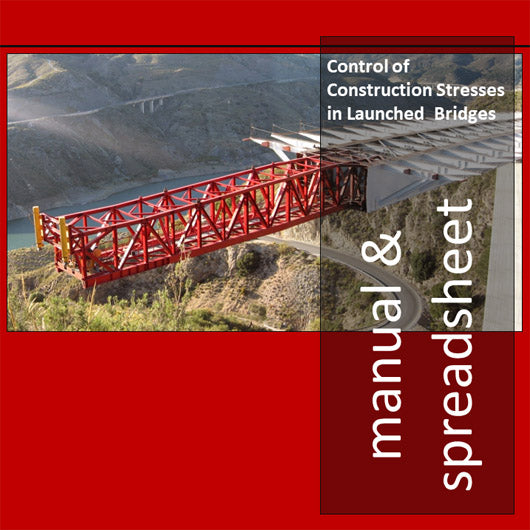
Control of Construction Stresses in Launched Bridges
23 pages & design spreadsheet
Regular price
$ 120.00
Sale
Self-weight bending and shear vary continuously during the incremental launching process. The increasing length of the front cantilever and recovery of the elastic deflection at nose landing govern the envelopes of self-weight bending and shear, and within those envelopes, the deck cross-sections cyclically range from peak negative bending and shear to peak positive bending.
The envelopes of self-weight bending and shear are more demanding in the front deck region and govern deck presizing. Without a launch nose, negative bending at the root of the front cantilever would be six times higher than in the rear pier regions. Shear would be double. Launchability criteria require a cylindrical deck geometry, and the launch nose controls self-weight bending and shear and the required level of launch post-tensioning.
Structures that present so many load conditions require accurate presizing. Optimizing the nose-deck interaction with a parametric spreadsheet shows the effects of the relative length, weight and stiffness of the nose, streamlines and accelerates the design of launched bridges, and mitigates the risk of remaking the launch stress analysis should presizing ultimately turn out inadequate.
In 23 pages, the eManual introduces the parameters that govern the nose-deck interaction, explores an analytical model of the nose-deck interaction and a step-by-step procedure for its optimization, and explains the use of parametric design charts for control of self-weight bending and shear in the front deck region by means of the relative length, weight and stiffness of the launch nose.
- Introduction
- Control of launch stresses
- The launch nose
- Nose-deck interaction
- Control of negative bending in the front deck region
- Control of positive bending in the front deck region
- Optimization of the nose-deck interaction
- Symbols
- References
The companion spreadsheet draws parametric design charts for positive and negative bending in the front span and at the nose-deck joint. Closed-form equations lead to excellent match with the results of launch stress analysis with structural analysis programs.
Manual and spreadsheet will become your productivity tools for value engineering and the pre-award design of launched bridges, will show you the effects of the relative length, weight and stiffness of the launch nose, and will avoid labor-intensive trial-and-error use of structural analysis programs during the deck presizing process.
